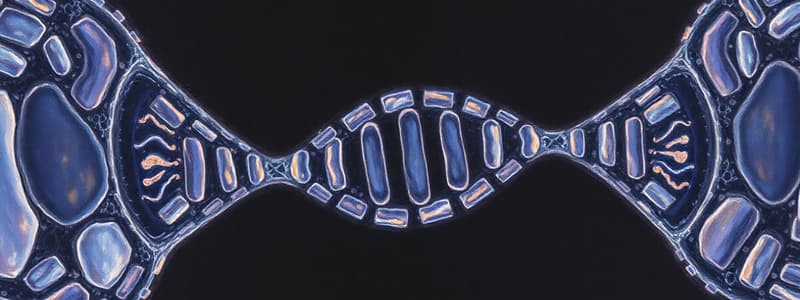Podcast
Questions and Answers
Which statement correctly describes the difference between eukaryotic and prokaryotic cells?
Which statement correctly describes the difference between eukaryotic and prokaryotic cells?
- Prokaryotic cells are typically larger than eukaryotic cells.
- Prokaryotic cells contain multiple linear chromosomes.
- Eukaryotic cells lack a membrane-bound nucleus.
- Eukaryotes have cells that contain a nucleus within a membrane. (correct)
What role does the vacuole play in a mature plant cell?
What role does the vacuole play in a mature plant cell?
- It conducts cellular respiration.
- It serves as the primary storage site for RNA.
- It helps in maintaining turgor pressure. (correct)
- It is responsible for photosynthesis.
Which feature is exclusive to plant cells when compared to animal cells?
Which feature is exclusive to plant cells when compared to animal cells?
- Nucleus
- Cell wall (correct)
- Cytoplasm
- Mitochondria
What is the primary function of the cell membrane?
What is the primary function of the cell membrane?
Which of the following microscopes is specifically used to detect optical patterns in liquid crystals?
Which of the following microscopes is specifically used to detect optical patterns in liquid crystals?
Flashcards are hidden until you start studying
Study Notes
Cell Structure and Function
- A cell is the fundamental unit of life, capable of independent existence, forming all living organisms and body tissues.
- Eukaryotic cells possess a membrane-bound nucleus, while prokaryotic cells contain a singular circular DNA chromosome.
DNA
- DNA, short for Deoxyribonucleic acid, carries the genetic information essential for development and function.
Types of Organisms
- Amoeba is a single-celled organism, representing one of the simplest forms of life.
Organization of Cells
- Cells cooperate to form tissues; multiple tissues collaborate to create organs, contributing to the structure and function of living organisms.
Comparison of Animal and Plant Cells
- Animal cells consist of a cell membrane, cytoplasm, and nucleus.
- Plant cells have additional structures: a cell wall, vacuole, and chloroplasts, alongside the cell membrane, cytoplasm, and nucleus.
Cell Functions
- The cell membrane acts as a protective boundary for the cell, regulating entry and exit of substances.
- Cytoplasm facilitates all cellular activities and contains organelles such as mitochondria and ribosomes, as well as food reserves like glycogen and starch.
- The nucleus stores chromosomes made of DNA, which contain the genetic blueprint of the organism.
- The cell wall in plant cells provides structural support and protection.
- A vacuole in mature plant cells stores cell sap, a dilute solution of salts and sugars.
- Chloroplasts contain chlorophyll, responsible for photosynthesis in plant cells.
Types of Microscopes
- Stereo Microscope: Provides a three-dimensional view of specimens.
- Compound Microscope: Commonly used for viewing small specimens with greater detail.
- Polarizing Microscope: Designed to detect unique optical patterns and phase defects in materials like liquid crystals.
Studying That Suits You
Use AI to generate personalized quizzes and flashcards to suit your learning preferences.




